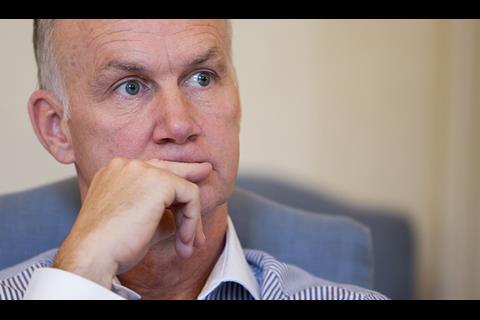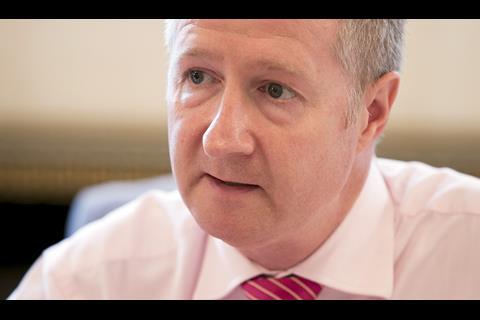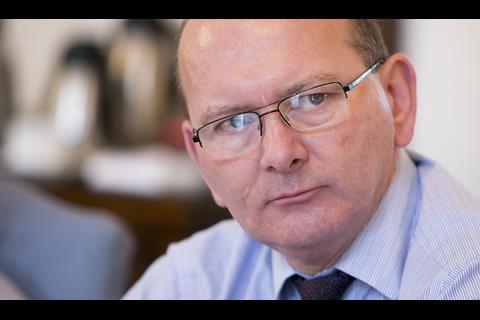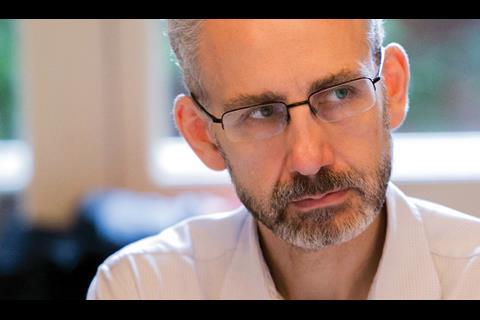HSJ’s latest roundtable attempted to get to grips with the myriad problems that have long bedevilled the NHS in its quest for effective, economical procurement. Alison Moore sat in
Roundatable participants
Dr Mahmood Adil, national QIPP adviser - clinical and financial engagement
Tim Cooper, delivery director for domain 3, NHS Improving Quality
Lance Gardner, chief executive, social enterprise Care Plus Group in Lincolnshire and member of NHS Supply Chain’s customer board
Alison Hopkins, chief executive, Accelerate CIC
Chris Hopson, chief executive, Foundation Trust Network
Rob Knott, national director, NHS procurement development
Keith Mahoney, non-executive director, Barking, Redbridge and Havering University Hospitals Trust and member of NHS Supply Chain’s customer board
Alastair McLellan, editor, HSJ (chair)
Joanna Timmerman, managing director for procurement, NHS Supply Chain
Richard Ward, director of purchasing and supply, Bristol and Weston Purchasing Consortium
The NHS has the potential to make massive savings and improve quality through better procurement of goods and services – but repeated attempts to do so have had limited success.
An HSJ roundtable, in association with NHS Supply Chain, brought together procurement experts and clinicians to debate how clinical involvement in the procurement process could contribute to cost effectiveness and better outcomes. And a passionate debate drew attention to some of the tensions between local decision-making – sometimes right down to individual clinicians – and the need to aggregate the NHS’s buying power to drive better deals.
‘Coming from a non-NHS background, what struck me was that the trust had a catalogue of 600,000 products’
HSJ editor Alastair McLellan, chairing the debate, opened by describing procurement as “the thorniest of thorny problems” which many groups of clever people had come together to debate over the years without achieving the success they would like.
And he cautioned the panel to keep their feet on the ground and to imagine they were back in the office with everyday constraints, rather than dealing with an ideal situation. “I don’t think we would all be gathered here if the NHS’s procurement of clinical supplies was all we wanted it to be,” he said.
Outlining the problem
To start the discussion, he asked members of the panel to outline the scale and nature of the problem as they saw it.
Keith Mahoney had a unique perspective on the issues, having worked for many years in procurement outside the NHS and now serving as a non-executive director at Barking, Redbridge and Havering University Hospitals Trust. “Coming from a non-NHS background, what struck me was that [the trust had] a catalogue of 600,000 products,” he said.
He was also struck by the lack of control and any process that defined how a product came on to the catalogue. And he raised the question of obsolescence – should products be taken out of the catalogue as other ones came in? “It just seemed to be at random,” he added.
Richard Ward, director of purchasing and supply for Bristol and Western Purchasing Consortium, outlined a number of areas he felt needed to be addressed. “The first one for me is relationship management,” he said. “I think we are extremely poor at developing relationships across the NHS, both internally and externally with the market.
“There is a massive amount of disaggregation. I don’t understand how we can’t aggregate across clinical settings. When we do have good strong contracts in place, there is a challenge around compliance.”
But he found some hopeful signs: although leadership was still an issue, it was improving. There was frustration around building a team concept of procurement and developing ownership.
Absence of data
National director of NHS procurement development Rob Knott gave some figures to illustrate the scale of the problem and the potential opportunities. The NHS non-pay bill was £22bn a year and it was looking to make savings of £1.5bn on that.
“It’s a very different type of scale from anything we might see even in the world’s largest organisations,” he said. Additional differences between the NHS and other organisations included disaggregation, a “complete absence” of data and intelligence, and the complexity of the NHS.
He pointed out that the NHS was not like government departments, which bought relatively little that was not for the use of employees.
“We spend £5bn a year on products that are either central to or touch patients. There are so many instances where we evaluate the same products time and time again.”
‘When it comes to variation we should look to standardise and rationalise as they do in private health groups’
Clinical preference was key to some of this: there was pressure from clinicians in areas where it would be possible to standardise products and services. “How do we address the difference between variation and innovation? When it comes to variation we should look to standardise and rationalise as they do in private health groups.”
Chief executive of the Foundation Trust Network Chris Hopson said his impression was that the problem was quite big. “If we have had several goes at it and failed, that indicates to me that there is a very significant problem here,” he said, adding that commitment at board level seemed to be the key to success.
“I don’t see anywhere near enough trusts and foundation trusts saying that procurement is something they need to focus on. Unless we get procurement as a strategic objective on trust boards then we will not get the progress we want to see,” he said.
Managing director of procurement at NHS Supply Chain Joanna Timmerman said: “The point about leadership and relationships is key. I think relationships need to go all the way through to a clinician and buyer building their relationship.” But she urged people to concentrate on facts rather than perceptions.
Clinicians were sometimes concerned about the impact on patient care but “if clinicians and procurement experts work together, all the outcomes will be improved”.
However, while in some areas there is good clinical engagement and buy-in, this is not happening everywhere. National QIPP adviser Dr Mahmood Adil said: “Wearing my medical and clinical hat I would see the fundamental question as why clinicians don’t want to engage or are not able to.”
He highlighted the importance of clinical engagement around big capital decisions such as new hospitals and, at a smaller but still significant scale, clinical supplies. A total of £25m a year was spent on gloves, with huge variations in cost across the country and potential identified savings of 28 per cent. He also pointed to sutures where costs could differ but outcomes are the same.
“Clinicians understand there is a variation but why can’t they engage with the agenda?” he said, questioning whether they were given opportunities to understand finance or whether there was a lack of basic knowledge of finance among clinicians.
Fleet of foot
Ms Timmerman said there was also an issue of sharing learning – if clinicians had found something that worked and saved money, it needed to be taken up more widely. Dr Adil said a barrier was that data was not available to clinicians and that, where it was available, it was not always understood. But there were examples where finance people and clinicians had been able to work together along a service line.
Mr Knott said that at his former trust, Hampshire Hospitals, orthopaedic surgeons had been given comparative figures on the costs of clinical supplies and this had shocked them.
‘There are millions of pounds’ worth of stock there just in case a clinician decided to do that procedure that day’
Lance Gardner, a nurse who now leads Lincolnshire social enterprise Care Plus Group, said he had worked in the NHS for many years but had only recently had to grapple with procurement issues. He said there was a focus on acute healthcare in much decision making on supplies, with community services just “given stuff” without consultation.
When things changed, such as new types of dressings being introduced, they did not know about it or what it cost – and they might not be funded for it.
Mr Gardner also highlighted the enormous impact individual clinicians’ preferences could have. Of the items available to the NHS to order through Supply Chain, 6,000 items accounted for 80 per cent of those supplied, he suggested. The remainder were due to personal preferences of clinicians – in some cases just one clinician.
“There are millions of pounds’ worth of stock there just in case that clinician decided to do that one [procedure] that day,” he said. “I lead on procurement in my organisation. We did an audit and found that we had enough gloves in stock for every nurse to have a new box every week for two years. They have no concept of price. One of our social enterprise colleagues has put the price of the product on the shelf and has reduced costs by 27 per cent overnight.”
NHS Improving Quality domain director Tim Cooper put the issues around procurement in the context of the financial constraints the NHS now faced. There might be no more money going into the NHS but there were opportunities for people to develop their services by saving money.
“There are some things that are large volume and small cost but there are others that are small volume and high costs.” However, he stressed that the NHS’s plans changed rapidly and it needed to remain “fleet of foot” to respond to changing circumstances.
Waste not, want not
But savings need not come solely from reducing prices. Alison Hopkins, who is chief executive of a wound care and lymphoedema social enterprise in East London, said: “What we needed to do was to look at key issues. For us that was the problem of waste. One of our patients died and their relatives brought in all the dressings that were in their home… on the table there was £3,500 worth of stoma care dressings.”
‘One of our patients died and their relatives brought in all the dressings that were in their home… on the table there was £3,500 worth of stoma care dressings’
But there was a need to look at this across pathways and take a joined up approach. Involving GP practices was part of this for her service. “In dressings we have to look at joined up prescribing issues. Repeat prescribing is a killer when we are looking at overspend.”
She said lack of clinical involvement was a major problem. It was necessary to reach down to the ground level, not just the board, so that healthcare workers could see the impact on the patient.
Sharing information could help in changing behaviour: she had started telling people what the difference in price of different products was (10 times in some cases). The response was often that they had no idea of the difference.
Mr Gardner stressed the importance of involving the people “who actually open the pack and use it” in decisions. And Mr Ward said what was needed was to get the right people across acute and community round the table – and that could include pharmacists, tissue viability nurses and so on. People would engage if they felt they had a contribution to the outcomes and could form a group working for a common purpose.
But speakers were also cautious about saving on purchasing being seen as simply buying the cheapest, as this could turn clinicians away from engagement.
Ms Hopkins said it needed to be pitched as getting the best product at the best price. She argued clinicians would not engage with financial issues if it was seen in terms of restricting clinical freedom, but would get involved if they saw their patients as being at the heart of the debate.
Securing improvements
So what can be done to improve the situation? Mr McLellan said that 11 years of reporting on health service policy had taught him that only a limited set of changes could be achieved within a time limit. He mentioned the Francis report with its 290 recommendations. “However good the plans are, we know that in three years’ time only four of the Francis recommendations will have made any difference,” he said.
So, given these limitations, he asked the panel to put forward one thing that could and would happen over the next three years to tackle some of the issues around procurement and clinical engagement. And he warned them he was not talking about things that should change but things that would.
Mr Ward said: “The biggest thing that has to happen and is happening is the engagement of clinicians and the leadership of clinicians in procurement. The clinician is the person who is going to use the product and the person who is directly linked to the patient.
“When you are a clinical director you run a small business. You have to balance the books [while] maintaining quality. That’s why you need that clinical input. Finance becomes a driver but you don’t want finance to compromise quality.”
But Mr McLellan questioned whether this would get clinicians to come to meetings to discuss procurement – or whether they would feel the financial situation was “not their problem.” Ms Timmerman said the question is what is in it for them.
Mr Ward said being part of informed decision making would encourage them. “But it is also being driven by the wider board agenda – that they are responsible and involved. The reality is starting to hit them. I really do think that the local situation and the local issues are coming home to rest.”
Lightbulb moment
For Mr Hopson the answer was leadership. “If the trust board thinks it is a really important strategic priority then leaders will spend some of their capital on trying to get their clinicians engaged.”
But Mr McLellan, playing devil’s advocate, questioned whether getting clinicians around the table with finance and procurement people would help when there were so many other current priorities, such as seven-day working.
Mr Hopson replied that a “lightbulb moment” was still to happen and that was what they needed to facilitate. Dr Adil said that when engagement was defined as encompassing four levels, only 20 per cent of trusts said they were at the highest level of frontline engagement.
Data would help clinicians become involved and this had not been available in the past but now would help influence their behaviour. And he pointed to the links between quality of care and cost: the NHS needed to prevent inpatient harm such as falls, which cost money as well as harming patients.
‘If you are looking at outcomes, if someone is going to come back in two years because we used the wrong product, then that is a cost’
Mr Mahoney said: “Cost is not just about price. It is about whole life cost. If you are looking at outcomes, if someone is going to come back in two years because we used the wrong product, then that is a cost.
“The problem is there is no common language and understanding, no information systems where people can sit down and understand together. The provision of that information is not being looked at. There are many good leaders who have led an army into being wiped out because they did not have information.”
But Ms Timmerman was optimistic about a scheme being considered for the North West, where a new approach to procurement orthopaedic supplies will be trialled under the government’s new procurement strategy. This will utilise economies of scale and would be clinically led, she said.
The Department of Health has said it is looking for savings of 10-15 per cent and it could become a template for working with industry in other areas. She said that data and evidence made available to teams gave transparency but that evidence needed to cover patient outcomes. Clinicians were looking for changes which could enable them to spend more time with their patients, and an efficient supply chain could help them in this.
“We have found that schemes that bring all parties to the table can find a solution,” she said. She advocated having clinical input at the start of the process, so that the clinicians could then be released to return to the front line and the procurement team could develop the solutions, guided by the input they had given. It was important to both use clinicians’ time wisely and to identify early adopters.
But Mr Ward added: “For me as a procurement professional, I want the clinicians really sitting by me in negotiations.” Clinical input could be very powerful in sending out messages, he added.
Sometimes getting clinicians involved in the nitty-gritty of negotiations can work. Mr Knott added: “I have found that we have to coach our clinicians around interactions with sales representatives and so on. Then the next time they lead on the negotiations and it is extraordinary to watch.”
Mr Cooper said clinicians were not trained to do this but could be put in situations where the stakes were high and they did not know how to behave. It was important to put savings back into clinical budgets so they could improve services rather than all the money disappearing into a big pot.
But there is a need to concentrate on the 20 per cent of supplies that represented 80 per cent of the costs, said Mr Ward. Sometimes it was necessary to bring in clinicians from different specialties where supplies overlapped. This helped to aggregate demand for supplies.
Wider picture
If an organisation needed to make savings on clinical supplies, it could indicate there was a deeper problem in the system - possibly delays in obtaining what it needed or restrictions on how money was spent, suggested Ms Hopkins.
She said there was a need to look at the wider picture - if someone could order dressings for pressure sores, were they able to provide pressure-relieving equipment at an earlier stage which would stop those pressure sores developing? This would link savings to better outcomes on their ward.
But is there a silver bullet to improve procurement across the NHS? Mr Knott was adamant there was not. But he pointed out that many of the big organisations across the world had one procurement process rather than 162, and made use of fantastic analytical data.
“The one thing that made the difference was investment in capability for that to happen at pace,” he said. He mentioned the new centre for procurement development the Department of Health is creating.
“It is not just focused on procurement people. We want to put video-based learning in there for non-financial people for trust boards,” he said.
‘When a supplier looks at a market with the number of procuring organisations the NHS has, it licks its lips with glee’
Mr Hopson added: “We are in the middle of a discussion with Rob about how exactly we make this work. It’s a key part of what needs to happen. “We have got to the point where we have tried to make this work by conventional management… I think we are in the place of management by embarrassment and pressure. I would force every single provider trust to put in the public domain all its procurement data for everything it spends over £500 a year.
“We could start to see what the unit cost of it was. The geeks would crawl over it, the suppliers would crawl over it… we would start to get real pressure on management boards.”
But this would only work if there were good quality information systems – and some trusts still did not have systems. “We still have places where procurement is done on bits of paper,” he said. “But we can’t put obligations on them until we support them to get the information systems in place. I think in the end the government will lose its patience.
“My sense is patience is beginning to wear thin – and so it should because this is not an acceptable situation. When a supplier looks at a market with the number of procuring organisations the NHS has, it licks its lips with glee.”
But this did not mean a totally centralised “national programme” for NHS procurement, he added. The governance arrangements for NHS organisations worked well 98 per cent of the time, but sometimes a more centralised approach was needed to achieve the best results.
Ms Timmerman said the available data suggested that 40 per cent of clinical supplies went through NHS Supply Chain; this data could also show where the opportunities for savings existed – £5m on gloves and £3m on sutures, for example. This information could be used now to make savings on some of these less contentious products.
Act smart
And Mr Ward said: “This is where we need to be smarter.” In the past, procurement managers had tried to coordinate so that they effectively managed markets ensuring sufficient completion between suppliers.
He pointed out the new procurement strategy did say organisations should publish spend data on their websites, although Mr McLellan questioned what level of granularity would be involved. And he suggested there was a tension between the NHS being a cohesive body and the direction of policy towards localism. “It seems to me there is a significant tension that will only grow louder,” he said.
But Mr Cooper was supportive of Mr Hopson’s ideas around publication of data, and wanted to push even faster. “I think we should be saying that we should publish our spend with every item we buy and then publish a national average with this so that non-executive directors and others can see what we are spending their money on.”
This would create a debate around whether they are spending more than is needed. Discrepancies around price performance between trusts would be exposed by this, pointed out Mr Knott. “Why is one tiny little trust with a tiny spend still beating large trusts? Is it that they have entered into a three year commitment based contract? Is their level of clinical engagement different? We would like to know.”
Mr McLellan raised the issue of whether value and quality considerations could have an opposite effect and could actually drive up costs. Mr Knott suggested price was an indicator of performance but there was a second question of how had that price been arrived at – and that might be different between organisations.
But Mr Gardner suggested the elephant in the room was clinical autonomy and whether anyone was prepared to challenge it. This had been changed in general practice, he suggested, where there were structures such as formularies and comparative referral rates.
‘Any leader has to recognise they don’t have to be experts on everything. Leadership is building the right people around you to help’
GPs could prescribe outside the formulary but this affected their pay packets, he said. And he suggested this could be used with the clinicians whose personal preferences led to the 600,000 items stocked by NHS Supply Chain. “If he believes so strongly that he needs to have that product he should pay for it.”
Ms Timmerman emphasised the importance of getting the right team into the room at the start of the process to decide what the needs of that department were. The procurement process could then be developed with that in mind.
For Dr Adil, capacity needed to be built on different levels including at undergraduate, postgraduate, and when doctors were at consultant level.
But this was happening – for example, all 31 medical schools were now looking at it and it was linked to quality improvement programmes undertaken at postgraduate level. Finance was now being built into the NHS Leadership Academy.
Mr McLellan said he often ran roundtables where the talk was of extra things doctors needed to learn - but his question was always what should they drop from the curriculum to allow room for these new elements? But Dr Adil said he was not suggesting anything which was an extra element. Consultants, he pointed out, had three out of their 10 sessions scheduled for other activities.
And Ms Timmerman said: “Any leader has to recognise they don’t have to be experts on everything. Leadership is building the right people around you to help.”
Baseline challenge
Mr Cooper suggested boards had to be able to challenge. “I want the board to get external validation of the decisions made within the organisation. Overall there has to be some sort of baseline challenge in there.”
Ms Hopkins emphasised the importance of getting clinicians engaged. But she added it had been hard work when her organisation had done this and involved understanding what problems clinicians encountered.
Clinicians wanted to have the freedom to make the right choices which could benefit patients: for example, they needed to be able to bring together money from different budgetary “pots”. When nurses in her organisation had been helped to reach out to more patients, the nurses could see how their outcomes were being improved.
They were also getting more involved with practice nurses around issues such as formularies. Some frontline nurses would now say that things had changed and they were getting the dressings they needed, for example. And delays in the system had reduced.
The organisation had also looked at what different teams were doing and could point out where problems were unique to one team, rather than a generalised problem, as a way to bring about change.
Finally Mr Mahoney called for a common language that was based around agreed outcomes – something which existed in other industries.
As far as the autonomy of NHS organisations was concerned, he pointed out that independent shops were able to collaborate around procurement and reap the benefits of this, while retaining their independence.
“They work around common systems, a common set of data and a common language,” he said. “What I see in the NHS is that every time we challenge something we hear that this trust measures it in a different way and we can’t have that discussion.”




































No comments yet